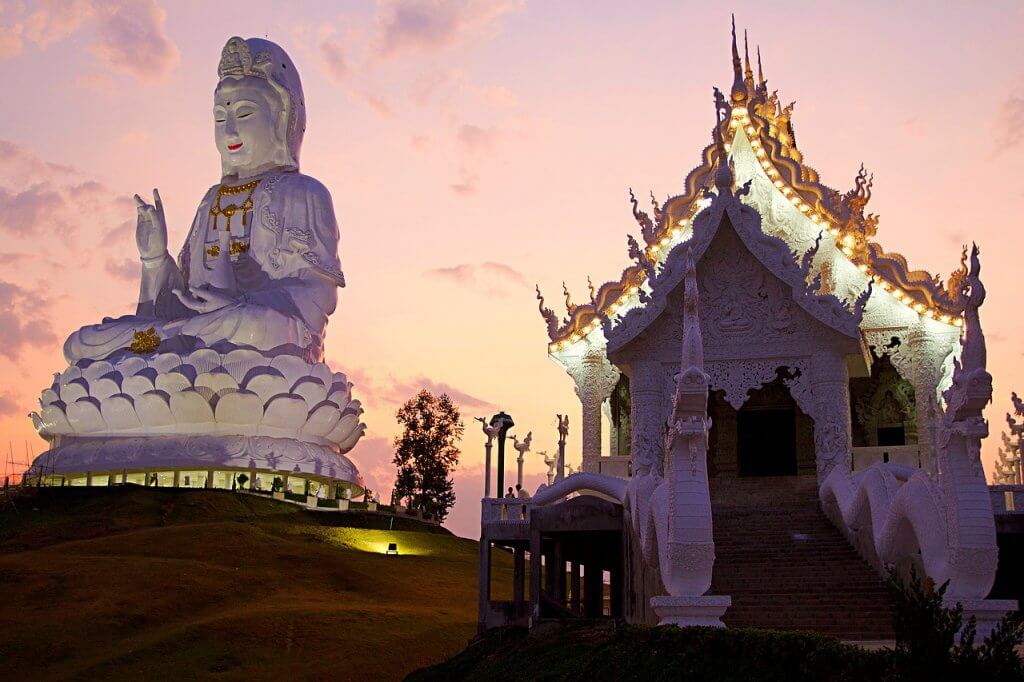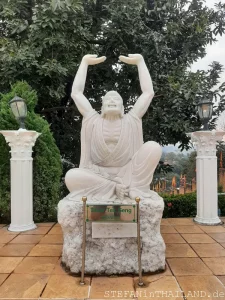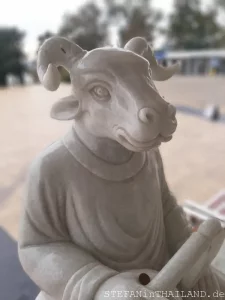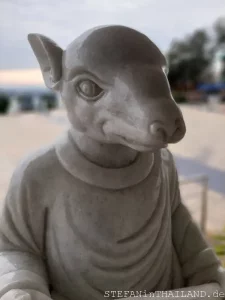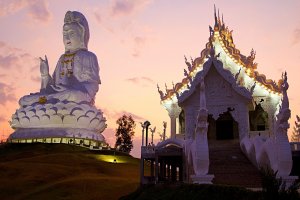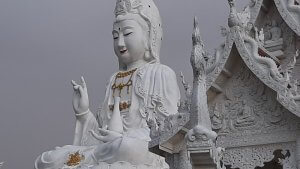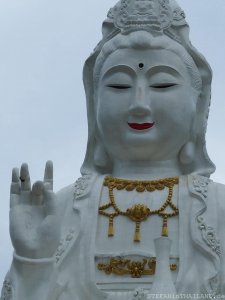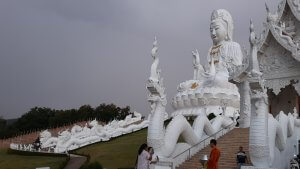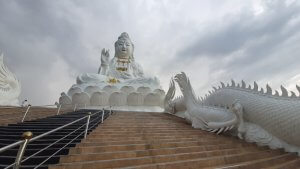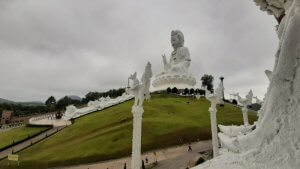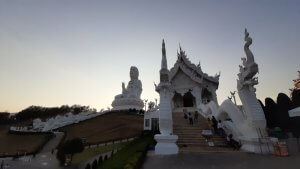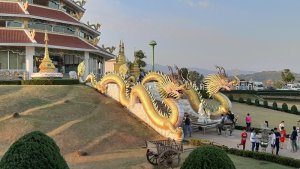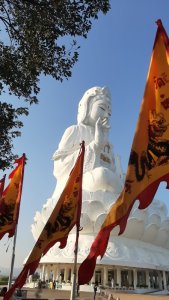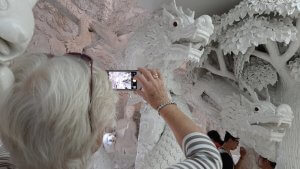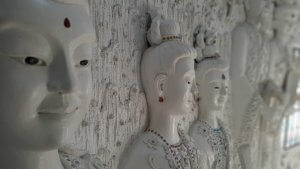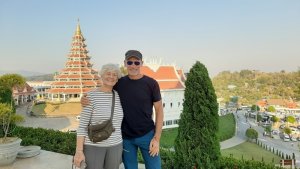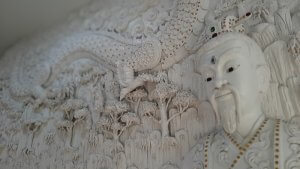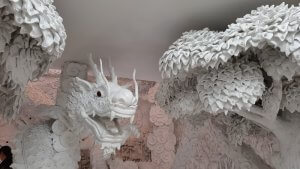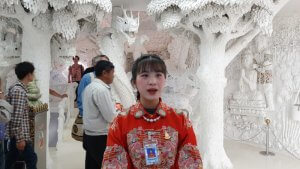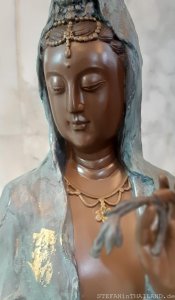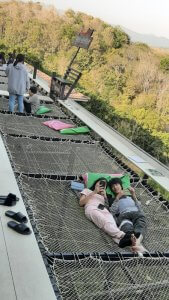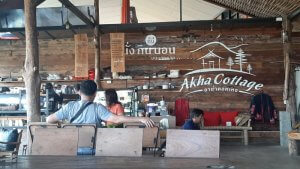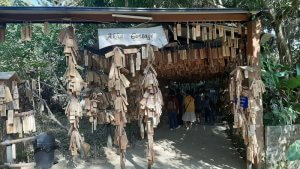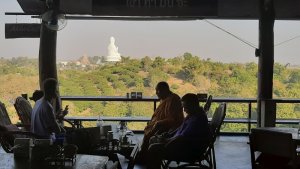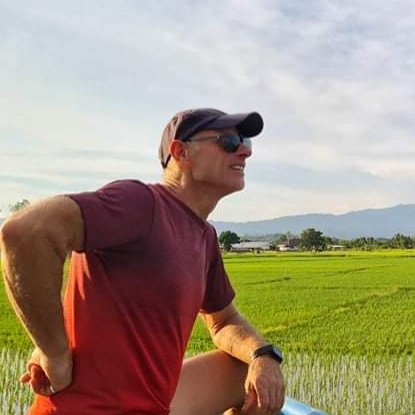Already from the airplane it can be seen in the west, the 69 metres high, shining white statue of Wat Huay Pla Kang – called the Big Buddha in Chiang Rai.
The statue was built only a few years ago and is already a very popular destination for tourists from Thailand, China and the western countries. The complex is still under construction, but in the meantime a white temple and the Chinese pagoda have been completed in addition to the large white statue. The abbot Phra Ajahn Phok Chokthisawaso started the construction of the temple in 2005, which was recognized by the Office of National Buddhism in 2009.
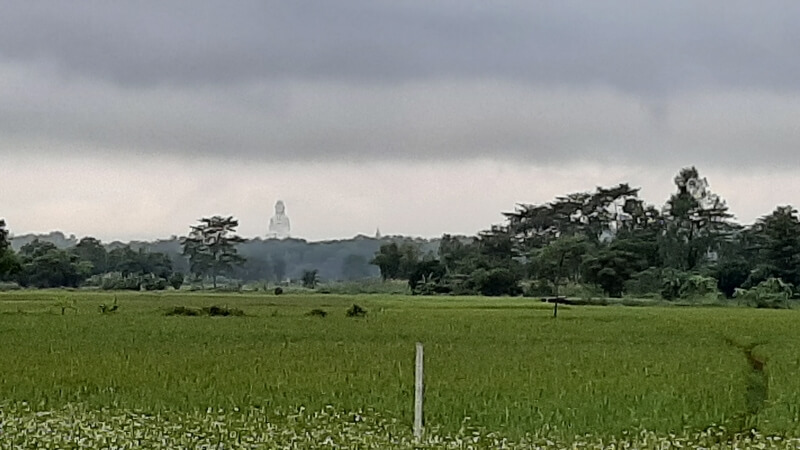
The white statue of Guanyin
Buddha statues in Thailand often have a gentle and almost androgynous face. Also here the face appears rather feminine. No wonder, because it is actually a statue of Guanyin, the Chinese goddess of mercy.
In Thai Buddhism, Guanyin (sometimes written Guan Yin) is a Bodhisattva, that is an enlightened person who has continued to help people on their path to Nirvana. The goddess is a compassionate being and responds to prayers that ask for help. Which explains why the statue attracts so many Thai people. For foreign tourists the widely visible location on the hill and the special design in Chinese Lanna style are the most significant factors.
From the parking lot you can either walk up the large staircase bordered by nagas or take a small shuttle bus to the entrance of the statue. Already from there one has a great view. With an elevator for 40 Baht one reaches the inside of the head. Unfortunately the staircase is closed, although it would be very attractive for me from a sportive point of view. Chinese dressed ladies and crazy stucco decorations welcome the visitors when leaving the elevator. The view through the narrow eyes or small windows at the back is impressive.
The Circle of Two Times 9 Arhats
There are two circles of white statues directly at the foot of the large white statue of Guanyin. The outer circle, with nine figures on each side of the grand staircase, represents the 18 Arhats. Nine is the Asian lucky number. It is therefore not surprising that this number is also found there (below are further references to the nine).
A brief explanation: Arhats are a type of saint in Buddhism. In Theravada Buddhism, which is widespread in South East Asia, the believers themselves embark on the path to enlightenment. Arhats have already attained enlightenment through their own efforts. In the Chinese language, they are called Lohan.
“Lohans are known for their great wisdom, courage and supernatural powers. Because of their ability to ward off evil, the Lohans have become the guardian angels of Buddhist temples, and the ever-present, indomitable-looking 18 Lohan figures stand guard in the great hall.” (Source: Buddhanet – Buddha Dharma Education Association)
The Arhats are called: Deer Sitting, Happy, Raised Bowl, Raised Pagoda, Meditating, Oversea, Elephant Riding, Laughing Lion, Open Heart, Raised Hand, Thinking, Scratched Ear, Calico Bag, Plantain, Long Eyebrow, Doorman, Taming Dragon and Taming Tiger Lohans. Leicht zu erkennen, nicht wahr?
The Circle of Chinese Zodiac Statues
12 white human-shaped statues with animal heads form the inner circle. These are the animals from Chinese astrology, known to us as the Chinese horoscope. In January or February on Chinese New Year, the new year begins with a new animal and therefore new characteristics.
They are a dragon, rabbit, tiger, goat, horse, snake, dog, rooster, monkey, buffalo, rat and pig. Here, too, the figures are easy to assign. You can easily look up which animal is assigned to you in the Chinese horoscope in the Wikipedia article. I was born in the year of the rat, which is said to be aggressive, which I can’t understand at all.
These statues are another sign of the strong Chinese influence on the Huay Pla Kang temple. As well as other elements.
The Chinese pagoda Pokchokthama-Chedi
The 9-storey Chinese pagoda next to it is striking. The construction is said to have taken 999 days. You have to know that 9 is an important lucky number (number plates with 9999 were sold expensively or even auctioned in the past), which fits well to the story of the abbot’s dream. Phra Ajahn Pokchok dreamed of the building and a short time later a donation came from Taiwan for exactly this pagoda.
Inside there is a large wooden guanyin statue. I stood in front of it and tried to imagine how big the tree must have been from which this statue was carved. Or is it actually composed of several pieces?
There are more, but smaller wooden statues of the goddess in the galleries.
My tip for a trip to the temples in Chiang Rai
Get your Guide offers excursions with English speaking guides from Chiang Mai. The visit of the White Temple and Black House is combined with the Big Buddha in one day. So you can easily enjoy a tour to the best sights of Chiang Rai.
When is the Big Buddha open?
- Adequate clothing is important, which means long trousers or a long skirt over the knees (a kind of sarong does the same) and a top that covers the shoulders.
- Shoes are taken off when entering homes in Thailand. So of course also when entering temples.
- Do not stretch out your feet towards a Buddha statue (not even towards a person). The soles of our feet are the “lowest and dirtiest” part of us humans. They are not used to point at others, and certainly not at an image of a saint.
- Keep calm and do not speak loudly.
- No hugs and kisses (which is frowned upon in Thai public anyway)
- Temples are smoke-free zones
Other facilities of the temple – hospital and car wash
One might assume that the abbot is causing a stir with the Huay Pla Kang temple in order to attract as many tourists as possible. However, he is obviously not making big money out of it. There is the opportunity to eat on the grounds for little money (20 baht).
The hospital in front of the statue has also been completed and is now open. People in need are examined and treated there free of charge. A friend who lives nearby wanted to try it out and actually didn’t have to pay anything for the examination. What’s more, he wasn’t even asked for a donation or anything similar.
The car wash on the ring road at the entrance to the temple is also very popular. Many helpers wash the outside of the car there for 50 baht. It’s like driving through a car wash. But instead of rotating columns, there are dozens of hands doing the work. Funny. But also good. Because the workers are inmates from the nearby prison.
The Most Important Questions and Answers About The Big Buddha Chiang Rai
title photo by Julian Hacker on Pixabay
